Buddhist architecture
| Part of a series on |
| Buddhism |
|---|
 |
|
Buddhist religious architecture developed in the Indian subcontinent. Three types of structures are associated with the religious architecture of early Buddhism: monasteries (viharas), places to venerate relics (stupas), and shrines or prayer halls (chaityas, also called chaitya grihas), which later came to be called temples in some places.
The initial function of a stupa was the veneration and safe-guarding of the relics of Gautama Buddha. The earliest surviving example of a stupa is in Sanchi (Madhya Pradesh).
In accordance with changes in religious practice, stupas were gradually incorporated into chaitya-grihas (prayer halls). These are exemplified by the complexes of the Ajanta Caves and the Ellora Caves (Maharashtra). The Mahabodhi Temple at Bodh Gaya in Bihar is another well-known example.
The Pagoda is an evolution of the Indian stupa.
Early development
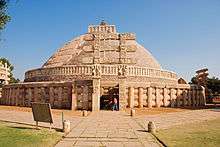

A characteristic new development at Buddhist religious sites was the stupa. Stupas were originally more sculpture than building, essentially markers of some holy site or commemorating a holy man who lived there. Later forms are more elaborate and also in many cases refer back to the Mount Meru model.
One of the earliest Buddhist sites still in existence is at Sanchi, India, and this is centred on a stupa said to have been built by King Ashoka (273–236 BCE). The original simple structure is encased in a later, more decorative one, and over two centuries the whole site was elaborated upon. The four cardinal points are marked by elaborate stone gateways.
As with Buddhist art, architecture followed the spread of Buddhism throughout south and east Asia and it was the early Indian models that served as a first reference point, even though Buddhism virtually disappeared from India itself in the 10th century.
Decoration of Buddhist sites became steadily more elaborate through the last two centuries BCE, with the introduction of tablets and friezes, including human figures, particularly on stupas. However, the Buddha was not represented in human form until the 1st century CE. Instead, aniconic symbols were used. This is treated in more detail in Buddhist art, Aniconic phase. It influenced the development of temples, which eventually became a backdrop for Buddha images in most cases.
As Buddhism spread, Buddhist architecture diverged in style, reflecting the similar trends in Buddhist art. Building form was also influenced to some extent by the different forms of Buddhism in the northern countries, practicing Mahayana Buddhism in the main and in the south where Theravada Buddhism prevailed.
Examples
 Mahabodhi temple, Gaya
Mahabodhi temple, Gaya
- Jetavanaramaya stupa is an example of brick-clad Buddhist architecture in Sri Lanka

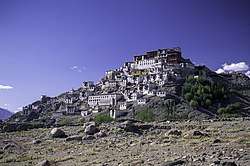
.jpg) Tawang Monastery in Arunachal Pradesh, was built in the 1600s, is the largest monastery in India and second largest in the world after the Potala Palace in Lhasa, Tibet
Tawang Monastery in Arunachal Pradesh, was built in the 1600s, is the largest monastery in India and second largest in the world after the Potala Palace in Lhasa, Tibet
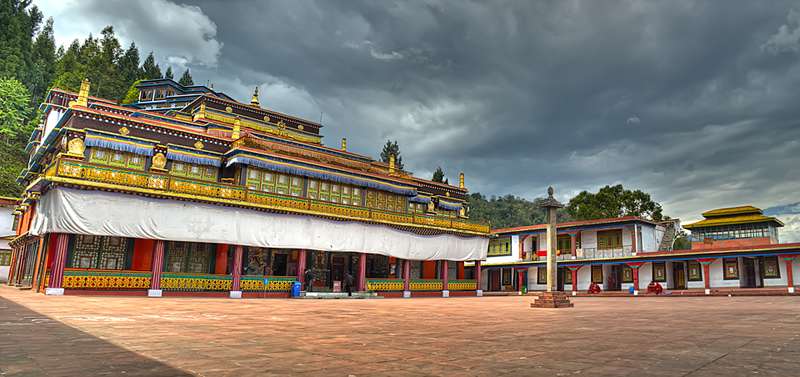 Rumtek Monastery in Sikkim was built under the direction of Changchub Dorje, 12th Karmapa Lama in the mid-1700s[1]
Rumtek Monastery in Sikkim was built under the direction of Changchub Dorje, 12th Karmapa Lama in the mid-1700s[1]
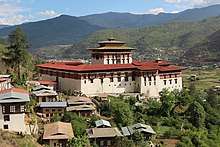 The Rinpung Dzong follows a distinctive type of fortress architecture found in the former and present Buddhist kingdoms of the Himalayas, most notably Bhutan
The Rinpung Dzong follows a distinctive type of fortress architecture found in the former and present Buddhist kingdoms of the Himalayas, most notably Bhutan
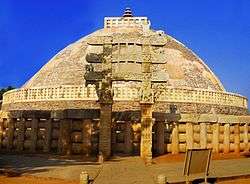 The Great Stupa in Sanchi, India is considered a cornerstone of Buddhist architecture
The Great Stupa in Sanchi, India is considered a cornerstone of Buddhist architecture
- Mongolian statue of Avalokiteśvara (Mongolian name: Migjid Janraisig), Gandantegchinlen Monastery. Tallest indoor statue in the world, 26.5-meter-high, 1996 rebuilt, (1913)
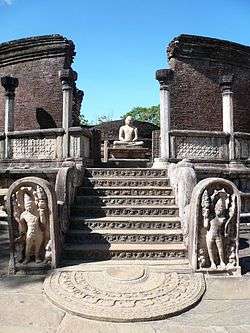 Vatadage Temple, in Polonnaruwa, is a uniquely Sri Lankan circular shrine enclosing a small dagoba. The vatadage has a three-tiered conical roof, spanning a height of 40–50 feet, without a center post, and supported by pillars of diminishing height
Vatadage Temple, in Polonnaruwa, is a uniquely Sri Lankan circular shrine enclosing a small dagoba. The vatadage has a three-tiered conical roof, spanning a height of 40–50 feet, without a center post, and supported by pillars of diminishing height

 Minar-i Chakri in 1836, Afghanistan
Minar-i Chakri in 1836, Afghanistan

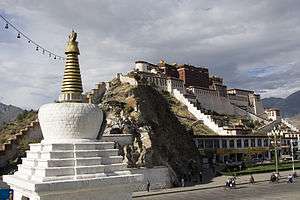
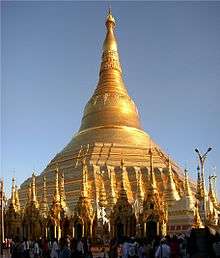 Shwedagon Pagoda, Myanmar
Shwedagon Pagoda, Myanmar
- Wat Phra Kaew, Bangkok, Thailand

 Great Stupa at Shambhala Mountain Center, United States
Great Stupa at Shambhala Mountain Center, United States
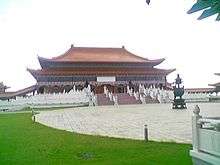 Nan Hua Main Temple, South Africa
Nan Hua Main Temple, South Africa
 Golden Temple of Shakyamuni Buddha, Kalmykia, Russian Federation
Golden Temple of Shakyamuni Buddha, Kalmykia, Russian Federation

See also
References
- ↑ Achary Tsultsem Gyatso; Mullard, Saul & Tsewang Paljor (Transl.): A Short Biography of Four Tibetan Lamas and Their Activities in Sikkim, in: Bulletin of Tibetology Nr. 49, 2/2005, p. 57.
| Wikimedia Commons has media related to Buddhist architecture. |
External links
- Peabody Essex Museum—Phillips Library: The Herbert Offen Research Collection — books and items on Buddhist architecture.